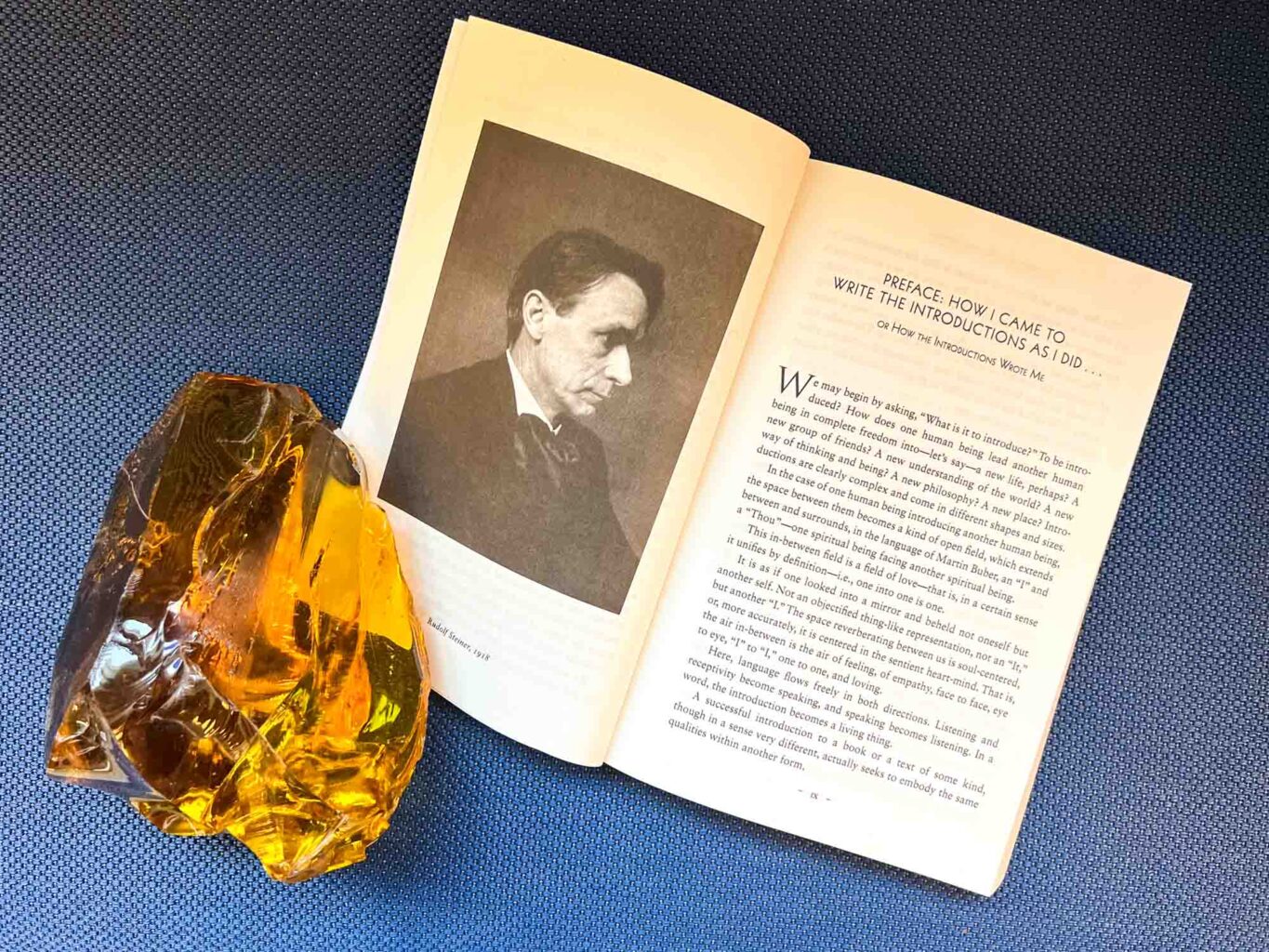Christopher Bamford, the long-time editor of SteinerBooks, crossed the threshold early in the morning of May 13, 2022. He had very recently been able to hold a copy of his book, ‹Encountering Rudolf Steiner›, which features many of his introductions to the Collected Works of Rudolf Steiner. This article contains highlights of the volume’s forty-page introduction by his longtime friend, Dr. Robert McDermott.
The deep aim, or intention, of an introduction (understood esoterically) is a ‹living understanding›, or, as the poet William Blake put it, the ability ‹to catch the bird in flight and fly with it.› If successful, this makes it possible for any reader to hear or translate, into his or her own understanding, what Rudolf Steiner is offering, within and beyond his words, in these texts of The Collected Works.
Christopher Bamford
In the late 1970s, at a salon at an elegant Park Avenue apartment, Christopher Bamford, the invited speaker, set out to recount the highlights of the history of Western esotericism. The guests were delighted by Christopher’s knowledge and his enthusiasm for his subject, but as sometimes happens with Christopher, his knowledge overwhelmed his purpose. After two hours, the talk that was intended to range from ancient Greek philosophy to nineteenth century European Romanticism was still focused on the genius of Pythagoras. …
With the late William Irwin (Bill) Thompson, founder and, for several decades, president of the Lindisfarne Association, Chris was one of the leaders of this distinguished fellowship [and] a frequent, admired speaker on a wide range of esoteric topics. … Chris founded and directed Lindisfarne Press to publish the works of visionary spiritual and esoteric authors. In the 1980s, Chris was named editor in chief of Anthroposophic Press, later named SteinerBooks. Fortunately for both publishers, Chris joined Lindisfarne to SteinerBooks. … From 2002 until 2018, he worked seamlessly with the late Gene Gollogly. …
In addition to his celebrated introductions to the Collected Works, Chris is also the author or editor of a half-dozen books that are distinctly his—i.e., books that he conceived and edited. His introductions to four of these books are included in the present volume; they are compilations of Steiner’s writings, but they are not included in Collected Works.
1999 ‹Staying Connected: How to Continue Your Relationships with Those Who Have Died. Selected Talks and Meditations by Rudolf Steiner›
2001 ‹Spiritualism, Madame Blavatsky, and Theosophy: An Eyewitness View of Occult History›
2003 ‹Isis Mary Sophia: Her Mission and Ours: Selected Lectures and Writings by Rudolf Steiner›
2004 ‹Start Now! A Book of Soul and Spiritual Exercises›
Additionally, beginning in the late 1970s (as mentioned), Chris worked intermittently for two decades on a history of Western esotericism. This study and writing enabled him to bring wide and deep knowledge of esotericism to his work as editor in chief of Anthroposophic Press/SteinerBooks and Lindisfarne Books. Further, serving as editor of these two imprints enabled him to add chapters to his history, published in 2003 as An Endless Trace: The Passionate Pursuit of Wisdom in the West.
Spiritual Thirst
Chris was spiritually thirsty, and karmically found the deep well of Steiner’s anthroposophic wisdom. His role as editor of SteinerBooks and primary author of introductions to Steiner’s Collected Works, has the sure stamp of karma. …
Chris’s success in these introductions is due to a steady avoidance of common flaws: they are thorough but not overwhelmed by detail and tangents; literary but not flowery; scholarly but not pedantic. Perhaps most remarkable, his introductions are reverent but neither boastful nor possessive; he shows Steiner’s importance but does not hold Steiner so close that the reader would be forced to access Steiner with Chris attached…
While it is not untrue to say that Steiner was a Christian, it would be truer to say that he advances Christianity in the light of his esoteric research. More specifically, Steiner’s purpose was to lead his audiences and readers to Christ. Similarly, with a deep Celtic and Russian Sophianic Christian sensibility, Chris’s encounter with Steiner’s Christology provides him with a spiritual path and career of service.
Autobiography: Chapters in the Course of My Life, 1861–1907
Christopher Bamford refers to Rudolf Steiner’s Autobiography as «both a testament and a legacy.» As a testament, it contains Steiner’s own account of the inner and outer events that contributed to his identity and mission. As a legacy, it sought to shape the way his life and teaching would be interpreted after his death—which he sensed might be not far off.
In ways that reveal the force of destiny, Steiner’s early life, the more as illumined by Chris’s introduction, clearly sowed the seeds of his adult life. As Chris writes,
He had achieved what he had set out to do. He had set down a clear record that could stand both as a commentary on the evolution of his teaching and as a directive for its continuation. He had demonstrated the clear, unbroken line of his own development. He had established the deep, abiding concerns that had directed his life. He had brought his life to a critical turning point, which many of his first readers could still recall. …
Toward the end of Chris’s informative and inspiring introduction, he offers an ideal summation: «The Autobiography is the account of a spiritual development.» It is Rudolf Steiner’s path to healing «the great wound that divides human beings from their cosmic birthright: to live as earthly and spiritual beings in a spiritual and physical universe.» Steiner’s Autobiography shows how, in a destined life, thinking can become deed, perception can become participation, and human beings through their own activity can become coworkers and co-creators of heaven and earth.


Start Now! A Book of Soul and Spiritual Exercises
Chris Bamford’s introduction to his Start Now! must rank as his most important writing on Rudolf Steiner, anthroposophy, and spiritual practice. The subtitle of this important book is not an exaggeration: Meditation Instructions, Meditations, Exercises, Verses for Living a Spiritual Year, Prayers for the Dead, and Other Practices for Beginning and Experienced Practitioners.
To a degree comparable to Steiner’s books on soul and spiritual exercises, this collection of his works was inspired by Chris’s own spiritual practices and devotion to spiritual and esoteric knowledge. The thirty-eight-page introduction is, in effect, a handbook or introductory guide to the spiritual life, complemented by the exercises that give this volume its practical value.
It would be difficult to imagine a more useful book for Anthroposophic practice. It shows the remarkable extent to which Chris is a ‹practitioner scholar›. Given the press of busy lives, the title of his book, while accurate, could as rightly be titled ‹Start Again!›
Isis Mary Sophia: Her Mission and Ours
Again personally, scarcely any topic in this compilation of Chris’s introductions is as inspiring or as close to Chris’s mind and heart as his often-quoted, poetic introduction to the collection that constitutes Isis Mary Sophia. … A scholar of Russian Sophiology—i.e., a scholar of the descriptions of Sophia in the writings of Vladimir Solovyov, Sergei Bulgakov, and Pavel Florenski—Chris begins his introduction with a remarkable passage from Vladimir Solovyov’s essay, ‹Three Meetings›:
Let it be known today, the Divine Feminine is descending to Earth in an incorruptible body. In the unfading light of the new Goddess, Heaven has become one with the depth.
Chris’s own poetic announcement reveals a similar beauty and authority. Since it was published in 2003, Chris’s volume, particularly for his informed and inspiring introduction, has been the obvious first source for anyone interested in Rudolf Steiner’s description of Sophia.
Staying Connected
… It is obvious that Chris has a deep, existential relation to this topic. While reading Chris’s writing on ‹staying connected› to the dead, Joseph Campbell’s description of the ‹Hero’s Journey› comes to mind. It is as though, while facing the immanent death of his beloved wife Tadea, Chris went in search of the meaning of what they were facing, and what would follow. Although it is too often not noticed, there is a necessary second half to the hero’s journey—the journey back to the community with wisdom, exactly what Chris, drawing on Steiner’s spiritual research, has provided. … Chris concludes on a personal note:
I must say that living and working with the concepts and exercises contained in these talks and meditations has changed my life. This is a most practical book. Do what it recommends and you will experience the presence of the dead in your lives. You will know that the community of human beings on both sides of the threshold is not theory, but reality.
Love and Its Meaning in the World
Chris’s introduction to ‹Love and Its Meaning in the World› is the concluding selection in this volume. …
In six short years, in addition to continuing (and continually deepening) his spiritual research and making every conceivable attempt to strengthen the Anthroposophical Society and endow it with all that it would need to carry on his mission after his death, Steiner founded at least five major initiatives, still thriving today, and nurtured their beginnings: the threefold movement for the renewal of the social organism; Waldorf education; anthroposophic medicine; a movement for religious renewal, The Christian Community; and biodynamic agriculture.
Steiner’s lectures on love are prevalent and defining throughout his career. His first book, Christianity as Mystical Fact (1902) includes several pages of ‹The Mystery of Love› and his profoundly moving last address, while he was ill and unlikely to recover, [enjoins us]:
Take the word of Love of the Will of Worlds
Into your soul’s aspiring, actively.
… It seems fitting that this introduction to Chris Bamford’s several dozen introductions to the writings and lectures of Rudolf Steiner should conclude on the theme of love. Steiner embodied and taught love; Chris engaged Steiner and returned the love—hundreds of thousands of words in front of fifty volumes over forty years. Love is not too strong a word for the engagement of Christopher Bamford with the life, mission, and work of Rudolf Steiner.
This is a reprint from the Summer-Fall 2022 issue of Being Human, with permission from editor John Beck.






Thank you for letting this be repeated!
I wasn’t ready to read it earlier …